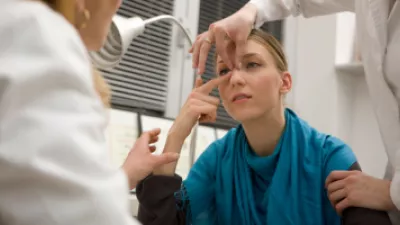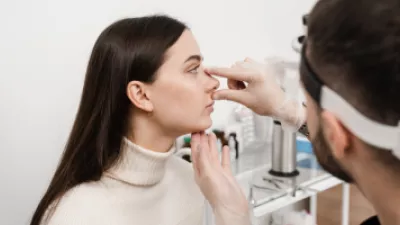The septum is a bone and cartilage structure that separates the right and left nasal cavities. Some patients may have a septum that blocks the natural flow of air on either side of the nose causing symptoms. Often patients with a deviated nasal septum will have nasal blockage not relieved by medications and typically worse on one side of the nose. Medicine for a deviated septum is not generally effective, though may help to shrink other membranes in the nose to improve nasal breathing. Due to the lack of effective medications, surgery is often the best alternative for fixing these issues. The Nebraska Medicine advanced ear, nose and throat specialists represent a variety of medical disciplines who fully diagnose your condition and design the best possible course of treatment customized to your specific needs. The whole-person, individualized plan of care we develop will treat you and your condition for maximum results.
Understanding Normal Septal Anatomy and Function
The septum provides support to the nose and divides the nasal cavities into right and left sections. It is made of both cartilage and bone. In the nasal cavity, the septum is covered by the lining of the nose or nasal mucosa and is made up of turbinates, thin bony structures that hang from the sidewalls of the nose. Turbinates help increase the surface space of the nasal cavity and help moisten and warm the air you breathe in. In addition to the septum, the inferior turbinates are also common contributors to nasal obstruction. If enlarged, the turbinates decrease the amount of free space in the nose for airflow.
What Causes a Deviated Septum?
There are many causes of septal deviation, ranging from trauma during birth to over growth of the cartilage, to sports or other injuries. Most people have some degree of septal deviation and it is uncommon to have a perfectly straight septum.
Turbinate Swelling
Turbinates swell and shrink as part of a normal cycle. Turbinates, however, can enlarge, permanently causing blockage. This enlargement may related to continued inflammation due to allergies or non-allergic irritation. In some cases prolonged use or abuse of over-the-counter decongestant nasal sprays can cause enlargement as well.
Septal Perforation or Hole in the Septum
A hole in the septum can develop for many reasons. You should see your ENT specialist to uncover the reason for the hole. A hole in the septum can cause symptoms of whistling when breathing through the nose, nose bleeds, crusting and dryness in the nose, and the feeling of decreased airflow. Often most of these symptoms can be dramatically improved with lubrication and nasal rinses. If those methods do not provide relief, there are several procedures that can be done to improve them, including a sepal button. That proceure involves, covering the hole with a medical plastic, or some may be repaired surgically by moving tissue from the inside of the nose to cover the hole.
How Do You Know if You Have a Deviated Septum? Symptoms include:
- Difficulty breathing through nose
- Snoring or loud breathing while sleeping
- Pain
- Increased nosebleeds
How We Treat a Deviated Septum
Treatment is typically only needed when the septal deviation causes symptoms medical treatment cannot resolve or when the deviation makes access to the sinuses difficult for patients having sinus surgery.
Medical Therapies
Medications such as antihistamines, decongestants, sprays and lubricants may alleviate symptoms but will not correct a deviated septum.
Surgical Therapies
Surgery to straighten your septum or septoplasty is often done as well as turbinate reduction. These two procedures provide a good chance of improving your nasal airway if you are a candidate for this surgery. The surgery may be done as an outpatient, meaning you will have the procedure and go home the same day if you do not have medical problems that would make an overnight hospital stay necessary, such as obstructive sleep apnea. The surgery involves lifting the lining of the septum and taking away or straightening the bent parts of cartilage and bone, and then replacing the lining and suturing it back in place. Splints are often used for a short time to keep the septum in the proper location while it is healing.
Our Locations
-

Ear, Nose, Throat (ENT) and Audiology at Village Pointe Health Center
110 N 175th St.
Get Directions
Omaha, NE 68118 -

Ear, Nose, Throat (ENT), Allergy and Audiology at Lauritzen Outpatient Center
4014 Leavenworth St.
Get Directions
Omaha, NE 68105
Highly Ranked Care
Nebraska Medicine is ranked among the nation’s best. Each year, U.S. News & World Report surveys the nation’s roughly 5,000 hospitals to come up with the year’s list of Best Hospitals.
Just 3 percent of the hospitals analyzed for Best Hospitals earn national ranking in even one specialty. Nebraska medicine was ranked nationally in ENT most recently in the 2017 U.S. News & World Report Best Hospitals ranking. Our team was also recognized as a high-performing hospital in ENT from 2011 to 2014.

